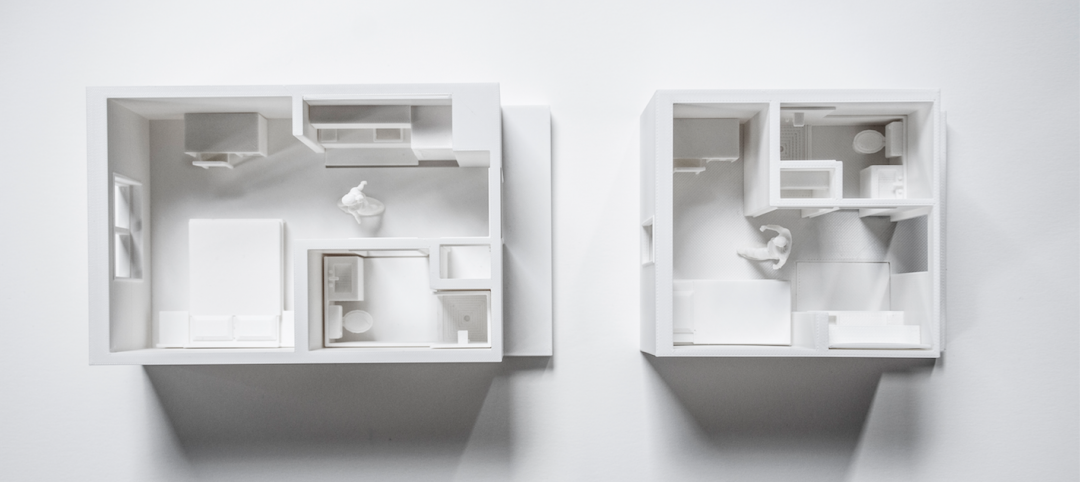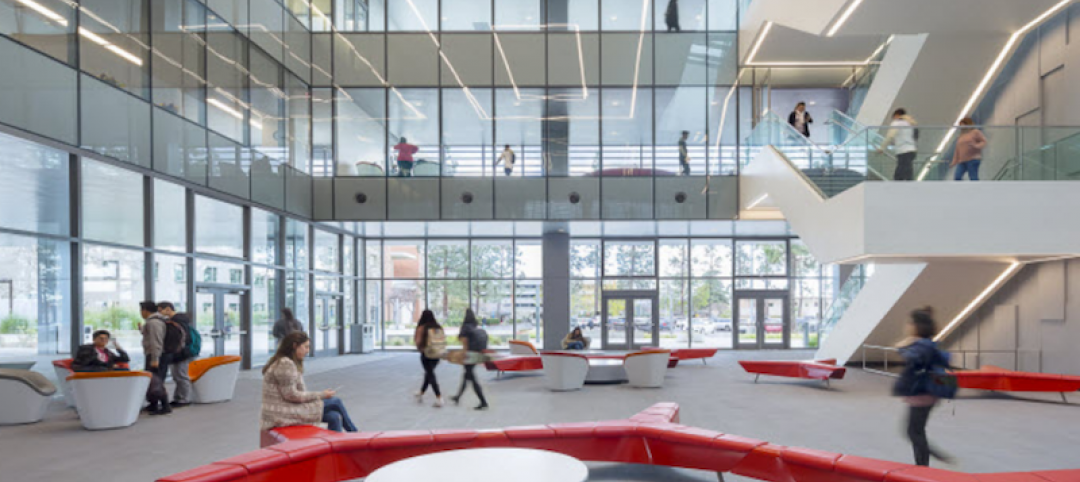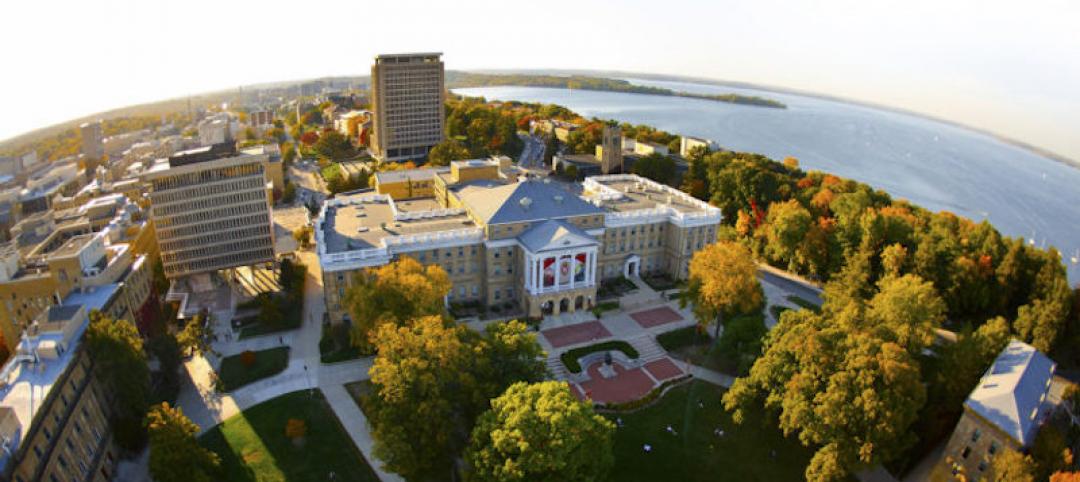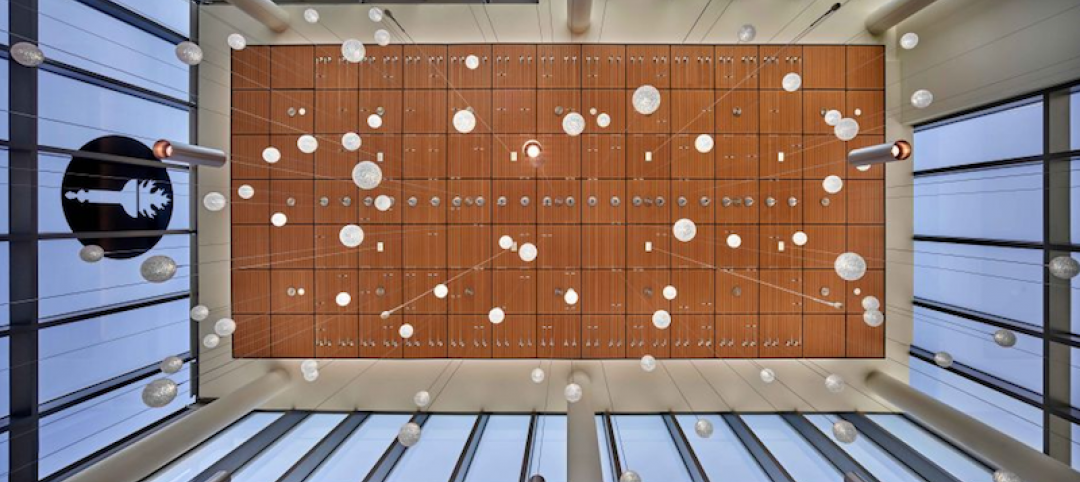
The city of Phoenix has sprawling suburbs, but its outward expansion caused the downtown core to stagnate—a problem not uncommon to other major metropolitan areas. Reviving the city became a hotbed issue for Mayor Phil Gordon, who envisioned a vibrant downtown that offered opportunities for living, working, learning, and playing.
The Mayor's plans for downtown redevelopment involved public-private partnerships, which led him to Arizona State University President Michael Crow. Crow was interested in expanding ASU's presence within the metro Phoenix area (ASU's main campus is in Tempe), so the city and school jointly developed a master plan for a new campus on nine city blocks. In 2006, voters approved $223 million in bonds, with $71 million slated for construction of the Walter Cronkite School of Journalism and Mass Communication, the new campus's first facility.
 |
| The two-story First Amendment Forum serves as the school’s “living room,” with a mezzanine level offering extra seating. Large windows between the forum and adjoining spaces, such as conference rooms and the Library & Student Resource Center, create a feeling that activities are always “on air.” |
The RFP for a design-build team was won by the alliance of HDR Architecture (executive architect), Ehrlich Architects (design architect), and Sundt Construction (GC) and required the team to adhere to an absolute fixed budget and a maximum 20-month timeline from award to occupancy certificate.
The Building Team utilized integrated project delivery and BIM to stay on time and on budget. Among other things, IPD and BIM enabled the Building Team to create detailed cost models instead of cost estimates, so that by the close of business every Friday the project budget was rectified.
IPD also helped with the fast-track schedule by allowing the project to be broken up into multiple packages, each with its own senior IPD leader and production team. The strategy allowed foundations to be poured before the superstructure design was complete and before the exterior skin was finalized. A special team was assigned to acquiring entitlements and building permits to accommodate the project's breakneck pace, and the city helped expedite the review process.
 |
| Studio spaces were built out quickly, but during interior improvements the floors received a top coating to create a camera-friendly flatness. |
The building's basic rectilinear form—a simple 30-foot-square exposed structural concrete column grid, burnished concrete block walls, and insulated cladding—was a practical choice for the project's budget and timeline. It enabled the Building Team to maximize square footage: ASU had a lengthy list of features they needed to squeeze into the six-story, 223,000-sf facility. The Walter Cronkite School of Journalism and Mass Communication is sandwiched between the building's ground floor, which houses the main lobby and retail and restaurant space, and the top floor, which is utilized by the city's PBS station, KAET/Channel 8. The university space includes 12 classrooms, seven working newsrooms, two state-of-the-art television studios, a library, a 150-seat theater-style auditorium, and a 1,500-sf exhibition gallery.
The centerpiece is a large “living room,” dubbed the First Amendment Forum. This two-story space—with mezzanine—is used as a gathering area for students during the day, while in the evening it becomes a public forum for students and industry leaders to engage in discussion and debate. Five hi-def flat-screen televisions and a large hi-def rear projector broadcast the day's news and other events. Walter Cronkite's famous sign-off, “And that's the way it is,” is inscribed on one wall.
To moderate the monolithic effect of the rectangular building, the Building Team sliced off a bit here and there and bumped out stairwells several feet from exterior walls. A combination of thin vertical and long horizontal windows, a wraparound exterior balcony, and multicolored corrugated metal cladding in a pattern inspired by FCC's radio spectrum chart further break up what could be a blocky exterior.
The facility opened in May 2008, and is adjacent to a pedestrian boulevard and across the street from a newly completed high-rise residence hall and a student union created by the adaptive reuse of a historic post office building. The city's new light rail system stops near the main entrance. The downtown now bustles with student life.
The project impressed Building Team Awards judge Dan Huntington. “Twenty months from start to certificate of occupancy on a building this size—that's pretty impressive,” says Huntington, SE, PE, LEED AP, associate principal at KJWW Engineering Consultants in Rock Island, Ill. “They had a very large task put in front of them, and they were very successful.”
Related Stories
Contractors | Apr 26, 2018
At Boston University’s dental school, ‘under construction’ won’t mean ‘closed for business’
A major renovation and addition are scheduled to minimize operational disruption.
Multifamily Housing | Mar 14, 2018
How to solve the housing crunch on college campuses
A growing number of public and private academic institutions are turning to designers and architects for alternative housing strategies—particularly in high-density areas on the East and West Coasts.
Hotel Facilities | Mar 6, 2018
A New Hampshire college offers student housing as hotel rooms during the summer
The opening of a new residence hall could help with Plymouth State University’s hospitality marketing.
Higher Education | Dec 11, 2017
Technology and higher ed: The 2030 Challenge
One of the ways in which we are already seeing the use of AR is as an improvement on typical curricula for anatomy in Health Sciences Education.
Engineers | Nov 2, 2017
CannonDesign expands its presence in Colorado with BWG acquisition
Future mergers could be in the offing.
Higher Education | Oct 26, 2017
Where campus meets corporate design
A building is much more than its appearance; it’s how the user will behave inside of it that determines its adaptability.
Adaptive Reuse | Oct 5, 2017
Wexford’s latest innovation center breaks ground in Providence
The campus is expected to include an Aloft hotel.
Higher Education | Sep 18, 2017
Campus landscape planning of the future: A University of Wisconsin-Madison case study
Recognizing that the future health of the campus and lake are interdependent, this innovative approach will achieve significant improvements in stormwater management and water quality within the university’s restored, more connected network of historic and culturally rich landscapes.
University Buildings | Sep 15, 2017
New Blinn College Residence Hall hopes to decrease the size of the campus housing wait list
In 2016, more than 400 students were placed on the wait list due to lack of available on-campus housing.
University Buildings | Sep 5, 2017
Rohrer College of Business supports the schools academic programs with several key spaces
Designed by KSS Architects and Goody Clancy, the new facility opened prior to the fall 2017 school year.
















